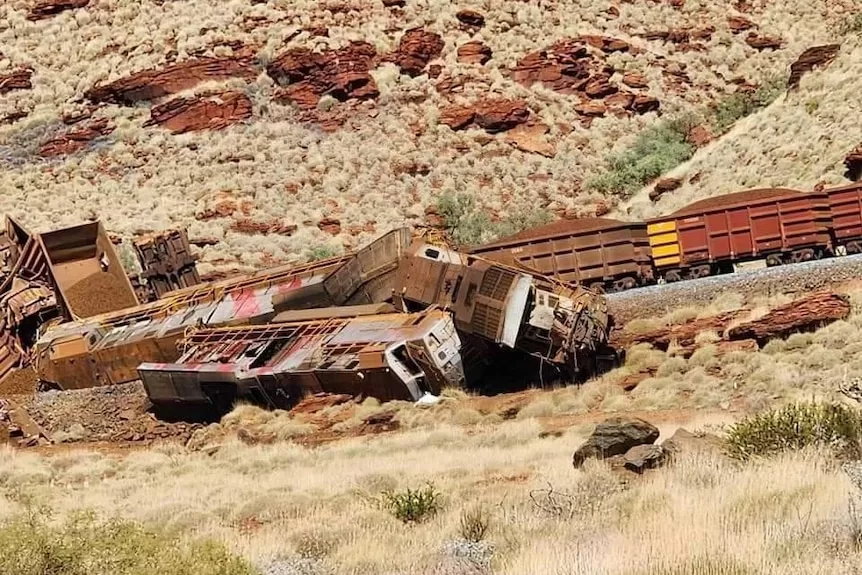- In short: The Mining and Energy Union is concerned about safety culture in the Pilbara after four major train derailments in 12 months.
- The union says the national regulator be stricter in its oversight and improve transparency.
- What’s next? An investigation into the most recent derailment near Karratha is ongoing.
The Mining and Energy Union (MEU) says future train crashes in Western Australia’s mining sector could lead to “major” fatalities if safety culture is not improved.
MEU Pilbara rail organiser Warren Johncock said workplace safety was in the spotlight after a spate of derailments in the state’s iron ore-rich north west, which fortunately did not lead to casualties.
“We honestly believe that there’s going to be a major fatality where a track maintenance crew is impacted by a train,” he said.
“There is more good luck than good management that we’re seeing with these safety incidents.”
Mr Johncock has worked on the Pilbara rail lines or helped regulate their safety for more than 30 years and said the culture had improved over time.
But he said there was a lack of transparency throughout the industry and called for stronger action from the Office of the National Rail Safety Regulator (ONRSR), where he worked for six years.
Mr Johncock was the lead ONRSR investigator in 2018 when a runaway BHP train hurtled along the tracks for more than 90 kilometres over about 40 minutes before it was intentionally derailed near Port Hedland.
Loading…
Four derailments in a year
There are dozens of iron ore mines in the Pilbara and four rail systems owned by major companies snake across the region to allow minerals to be transported from the pits to the coast for shipping.
There have been four major derailments in the past year, including a crash last month that left multiple Rio Tinto workers unharmed but shaken and lucky to be alive, according to the MEU.
On Tuesday Rio Tinto iron ore chief executive Simon Trott said an investigation into the derailment was ongoing, but early findings suggested there was a “gap” in a “procedure” on the rail line, which had since been rectified.
A Rio Tinto spokesperson declined to elaborate on the specific problems identified and how they had been rectified.
Mr Johncock said such incidents could easily escalate and felt ONRSR should provide stricter oversight.
He raised a number of concerns, including inexperience in the rail sector within ONRSR and a lack of transparency and direct communication from the regulator to workers.
“The regulator doesn’t see the value in having people who have rail experience go out and do inspections and audits and regulatory activities,” Mr Johncock said.
“Very, very few people out on the ground will know who they are when they come to town.
“Generally, most rail safety workers up there haven’t had much to do with the regulator, if anything.”
Concerns over safety data
ONRSR releases annual safety reports that contain data about safety incidents in all types of rail transport, including freight.
But Mr Johncock said changes to the reports in 2022/23 meant safety incidents involving trains going past red signals were not included in the data if it occurred within a rail yard.
These are known as proceed authorities exceeded (PAE) and are often precursors to more serious incidents such as collisions and derailments.
Mr Johncock said excluding PAEs in yards from the reported figures distorted the data and perceptions on safety.
“It’s about the story you want to tell, opposed to what may be the facts,” he said.
An ONRSR spokesman said the regulator had a “passionate and highly skilled workforce” dedicated to safe railways.
“In carrying out its functions under Rail Safety National Law, ONRSR works with a wide range of safety stakeholders and this includes having significant and regular interactions with front line rail safety workers right across the country and their representing unions,” the spokesman said.
“ONRSR is committed to the continuous improvement of safety on Australia’s railways and continues to monitor rail operations in the Pilbara through an ongoing program of audits and inspections.”
The spokesman said data collection and reporting changes were implemented in 2022 and that PAEs within yards were still reported to ONRSR for use in developing its annual work program and general rail safety strategies.
Find more local news
Browse for your location and find more local ABC News and information
